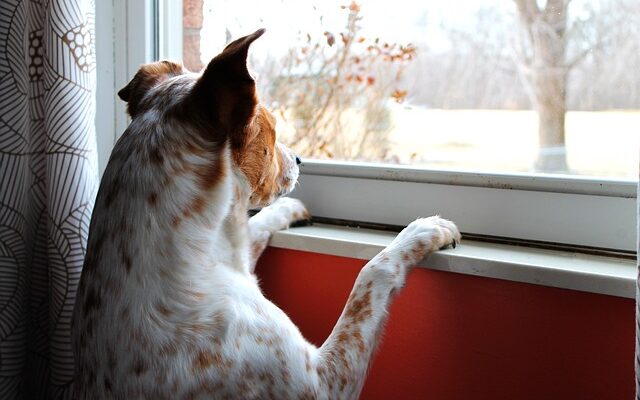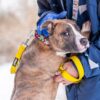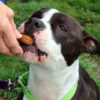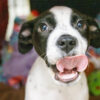Treatment for Mild Separation Anxiety
If your dog has a mild case of separation anxiety, counterconditioning might reduce or resolve the problem. Counterconditioning is a treatment process that changes an animal’s fearful, anxious or aggressive reaction to a pleasant relaxing one. It’s done by associating the sight or presence of a feared or disliked person, animal, place, object or situation with something really good, something the dog loves. Over time the dog learns that whatever he fears actually predicts good things for him.
For dogs with separation anxiety, counterconditioning focuses on developing an association between being alone and good things like delicious food. To develop this kind of association, every time you leave the house you can offer your dog a puzzle toy stuffed with food that will take him at least 20-30 minutes to finish. For example, try giving your dog a KONG stuffed with something tasty like low-fat cream cheese, Cheez-Whiz or low fat peanut butter, frozen banana and cottage cheese or canned dog food mixed with kibble. Always freeze the items so that it lasts longer. A KONG can even be frozen so that getting all the food out takes even longer. Your dog might also love a Buster Cube, a Kibble Nibble or a TreatStik filled with kibble. Be sure to remove these special toys as soon as you return home so that your dog only has access to them and the high-value foods inside when he is by himself. You can feed your dog all his daily meals in special toys. For example, you can give your dog a KONG or two stuffed with his breakfast and some tasty treats every morning before going to work.
Treatment for Moderate to Severe Separation Anxiety
Moderate or severe cases of separation anxiety require a more complex desensitization and counterconditioning program. In these cases, it’s crucial to gradually accustom a dog to being alone by starting with short separations that do not produce anxiety and then gradually increasing the duration of the separations over many weeks of daily sessions.
Desensitization and counterconditioning are complex and can be tricky to carry out. Fear must be avoided or the procedure will backfire and the dog will get more frightened.
The following steps briefly describe a desensitization and counter-conditioning program.
Step One: Predeparture Cues
Some dogs begin to feel anxious while their guardians get ready to leave. For example, a dog might start to pace, pant and whine when he notices his guardian applying makeup, putting on shoes and a coat, and then picking up a bag or car keys. (If your dog doesn’t show signs of anxiety when you’re preparing to leave him alone, you can just skip to step two below.) Guardians of dogs who become upset during predeparture rituals are unable to leave – even for a few seconds – without triggering their dog’s extreme anxiety. Your dog may see subtle cues that you’re leaving (like putting on your coat or picking up your keys) and get so anxious about being left alone that he can’t control himself and forgets that you will come back.
One treatment approach to this “predeparture anxiety” is to teach your dog that when you pick up your keys or put on your coat it doesn’t always mean you’re leaving. You can do this by exposing your dog to these cues in various orders several times a day without leaving. For example, put on your boots and coat and then just watch TV instead of leaving. Or pick up your keys and then sit down at the kitchen table for a while. This will reduce your dog’s anxiety because these cues won’t always lead to your departure and your dog won’t get so anxious when he sees them. Please be aware that your dog has many years of learning the significance of your departure cues, so in order to learn that the cues no longer predict your long absences, your dog must experience the fake cues many, many times a day for many weeks. After your dog stops becoming anxious when he sees you getting ready to leave, you can move on to the next step below.
Step Two: Graduated Departures/Absences
If your dog is less anxious before you leave, you can probably skip the predeparture treatment above and start with very short departures. The main rule is to plan your absences to be shorter than the time it takes for your dog to become upset. To get started, train your dog to perform out-of-sight stays by an inside door inside a room such as the bathroom. You can teach your dog to sit or down and stay while you go to the other side of the bathroom door. Gradually increase the length of time you wait on the other side of the door, out of the dog’s sight. You can also work on getting your dog used to predeparture cues as you practice the stay. For example, ask your dog to stay. Then put on your coat, pick up your purse and go into the bathroom while your do continues to stay.
- Progress to doing out-of-sight exercises at a bedroom door, and then later at an exit door. If you always leave through the front door, do the exercises at the back door first. By the time you start working with your dog at exit doors, he shouldn’t behave anxiously because he has a history of playing the “stay game.”
- At this point, you can start to incorporate very short absences into your training. Start with absences that last only 1-2 seconds, and then slowly increase the time you are out of the dog’s sight. When you have trained up to separations of 5-10 seconds, build in counterconditioning by giving your dog a stuffed food toy just before you step out the door. The food-stuffed toy also works as a safety cue that tells the dog that this is a
“safe” separation. - During your sessions, be sure to wait a few minutes between absences. After each short separation, it is important to make sure that your dog is completely relaxed before you leave again. If you leave again right away, while your dog is still excited about your return from the previous separation, he will already feel aroused when he experiences the next absence. This arousal may make him less able to tolerate the next separation, making the problem worse rather than better.
- Remember to behave in a very calm and quiet manner when going out and coming in. This will lower the contrast between times when you are there and times when you are gone.
- You must judge when your dog is able to tolerate an increase in the length of separation. Each dog reacts differently, so there are no standard timelines. Deciding when to increase the time your dog is alone can be very difficult and many pet parents make errors. They want the treatment to progress quickly so they expose their dogs to durations that are too long, which provokes anxiety and worsens the problem. To prevent this kind of mistake watch for signs of stress in your dog. These signs might include dilated pupils, panting, yawning, salivating, trembling, pacing and an exuberant greeting. If you detect stress, you should back up and shorten the length of your departures to a point where your dog can relax again. Then start at that level and progress more slowly.
- You will need to spend a significant amount of time building up to 40 minute absences because most of your dog’s anxious responses will occur within the first 40 minutes that he is alone. This means that over weeks of conditioning, you will increase the duration of your departures by only a few seconds each session, or every couple of sessions, depending on your dog’s tolerance at each level. Once your dog can tolerate 40 minutes of separation from you, you can increase absences by larger chunks of time (5 minute increments at first, then later 15 minute increments). Once your dog can be alone for 90 minutes without getting upset or anxious, he can probably handle 4-8 hours. (Just to be safe, try leaving him alone for 4 hours at first and then work up to 8 hours over a few days.)
- This treatment process can be accomplished in a few weeks if you can conduct several daily sessions on the weekends and twice-daily sessions during the work week, usually before leaving work and in the evening.
A Necessary Component of Separation Anxiety Treatment
During desensitization to any type of fear, it is essential to ensure that your dog never experiences the full-blown version of whatever provokes his anxiety or fear. He must experience only a low-intensity version that doesn’t frighten him. Otherwise, he won’t learn to feel calm and comfortable in situations that upset him. This means that during treatment for separation anxiety, your dog cannot be left alone except during desensitization sessions. Fortunately there are plenty of alternative arrangements.
- If possible, take your dog to work with you.
- Arrange for a family member, friend, or dog sitter to come to your home and stay with your dog when you are not there. (Most dogs suffering from separation anxiety are fine as long as someone is with them. That someone doesn’t necessarily need to be you.)
- Take your dog to a sitter’s house or to doggy daycare.
In addition to your graduated absences exercises, all greetings (hellos and goodbyes) should be conducted in a very calm manner. When saying goodbye, just give your dog a pat on the head, say goodbye and leave. Similarly, when arriving home, say hello to your dog and then don’t pay any more attention to him until he’s calm and relaxed. The amount of time it takes for your dog to relax once you’ve returned home will depend on his level of anxiety and individual temperament. To decrease your dog’s excitement level when you come home, it might help to distract him by asking him to perform some simple behaviors that he’s already learned such as sit, down or shake.
Provide Plenty of “Jobs” for Your Dog to Do
Providing lots of physical and mental stimulation is a vital part of treating many behavior problems, especially those involving anxiety. Exercising your dog’s mind and body can greatly enrich his life, decrease stress and provide appropriate outlets for normal dog behaviors. Additionally, a physically and mentally tired dog doesn’t have much excess energy to expend when he’s left alone. To keep your dog busy and happy, try the following suggestions.
- Give your dog at least 30 minutes of aerobic activity (for example, running and swimming) every day. Try to exercise your dog right before you have to leave him by himself. This might help him relax and rest while you are gone but be sure to offer a few minutes of decompression activities after high energy play. Have the dog sniff around and find some treats, do a calm walk and some basic cues, and give enrichment, etc.
- Play fun interactive games with your dog, such as fetch and tug-of-war.
- Take your dog on daily walks and outings. Take different routes and visit new places as often as possible so that he can experience novel smells and sights.
- If your dog likes other dogs, let him play off-leash with his canine buddies
- Frequently provide food puzzle toys like Kong, the Buster Cube, the Tricky Treat Ball and the Tug-A-Jug. You can feed your dog his meals in these toys or stuff them with a little peanut butter, cheese or yogurt. Also give your dog a variety of attractive edible and inedible chew things. Puzzle toys and chew items encourage chewing and licking, which have been shown to have a calming effect on dogs. Be sure to provide them whenever you leave your dog alone.
- Make your dog “hunt” for his meals by hiding small piles of his kibble around your house or yard when you leave. Most dogs love this game!
- Enroll in a reward-based training class to increase your dog’s mental activity and enhance the bond between you and your dog.
- Get involved in dog sports such as agility, freestyle (dancing with your dog) or flyball.
*You can visit the ASPCA’s website for additional training and behavior information at www.aspca.org/pet-care/dog-care








